Abstract
Despite suppressive combination antiretroviral therapy (ART), latent HIV-1 proviruses persist in patients. This latent reservoir is established within 48–72 h after infection, has a long half-life1,2, enables viral rebound when ART is interrupted, and is the major barrier to a cure for HIV-13. Latent cells are exceedingly rare in blood (∼1 per 1 × 106 CD4+ T cells) and are typically enumerated by indirect means, such as viral outgrowth assays4,5. We report a new strategy to purify and characterize single reactivated latent cells from HIV-1-infected individuals on suppressive ART. Surface expression of viral envelope protein was used to enrich reactivated latent T cells producing HIV RNA, and single-cell analysis was performed to identify intact virus. Reactivated latent cells produce full-length viruses that are identical to those found in viral outgrowth cultures and represent clones of in vivo expanded T cells, as determined by their T cell receptor sequence. Gene-expression analysis revealed that these cells share a transcriptional profile that includes expression of genes implicated in silencing the virus. We conclude that reactivated latent T cells isolated from blood can share a gene-expression program that allows for cell division without activation of the cell death pathways that are normally triggered by HIV-1 replication.
This is a preview of subscription content, access via your institution
Access options
Access Nature and 54 other Nature Portfolio journals
Get Nature+, our best-value online-access subscription
$29.99 / 30 days
cancel any time
Subscribe to this journal
Receive 12 print issues and online access
$209.00 per year
only $17.42 per issue
Buy this article
- Purchase on Springer Link
- Instant access to full article PDF
Prices may be subject to local taxes which are calculated during checkout




Similar content being viewed by others
References
Crooks, A. M. et al. Precise quantitation of the latent HIV-1 reservoir: implications for eradication strategies. J. Infect. Dis. 212, 1361–1365 (2015).
Siliciano, J. D. et al. Long-term follow-up studies confirm the stability of the latent reservoir for HIV-1 in resting CD4+ T cells. Nat. Med. 9, 727–728 (2003).
Murray, A. J., Kwon, K. J., Farber, D. L. & Siliciano, R. F. The latent reservoir for HIV-1: how immunologic memory and clonal expansion contribute to hiv-1 persistence. J. Immunol. 197, 407–417 (2016).
Henrich, T. J., Deeks, S. G. & Pillai, S. K. Measuring the size of the latent human immunodeficiency virus reservoir: the present and future of evaluating eradication strategies. J. Infect. Dis. 215, S134–S141 (2017). suppl_3.
Spina, C. A. et al. An in-depth comparison of latent HIV-1 reactivation in multiple cell model systems and resting CD4+ T cells from aviremic patients. PLoS Pathog. 9, e1003834 (2013).
Pape, K. A., Taylor, J. J., Maul, R. W., Gearhart, P. J. & Jenkins, M. K. Different B cell populations mediate early and late memory during an endogenous immune response. Science 331, 1203–1207 (2011).
Laird, G. M. et al. Rapid quantification of the latent reservoir for HIV-1 using a viral outgrowth assay. PLoS Pathog. 9, e1003398 (2013).
Scheid, J. F. et al. Sequence and structural convergence of broad and potent HIV antibodies that mimic CD4 binding. Science 333, 1633–1637 (2011).
Mouquet, H. et al. Complex-type N-glycan recognition by potent broadly neutralizing HIV antibodies. Proc. Natl. Acad. Sci. USA 109, E3268–E3277 (2012).
Walker, L. M. et al. Broad and potent neutralizing antibodies from an African donor reveal a new HIV-1 vaccine target. Science 326, 285–289 (2009).
Gaublomme, J. T. et al. Single-cell genomics unveils critical regulators of Th17 cell pathogenicity. Cell 163, 1400–1412 (2015).
Sherrill-Mix, S., Ocwieja, K. E. & Bushman, F. D. Gene activity in primary T cells infected with HIV89.6: intron retention and induction of genomic repeats. Retrovirology 12, 79 (2015).
Hunt, M. et al. IVA: accurate de novo assembly of RNA virus genomes. Bioinformatics 31, 2374–2376 (2015).
Lorenzi, J. C. et al. Paired quantitative and qualitative assessment of the replication-competent HIV-1 reservoir and comparison with integrated proviralDNA. Proc. Natl. Acad. Sci. USA 113, E7908–E7916 (2016).
Mullins, J. I. & Frenkel, L. M. Clonal expansion of human immunodeficiency virus-infected cells and human immunodeficiency virus persistence during antiretroviral therapy. J. Infect. Dis. 215, S119–S127 (2017). suppl_3.
Cohn, L. B. et al. HIV-1 integration landscape during latent and active infection. Cell 160, 420–432 (2015).
Wagner, T. A. et al. HIV latency. Proliferation of cells with HIV integrated into cancer genes contributes to persistent infection. Science 345, 570–573 (2014).
Maldarelli, F. et al. HIV latency. Specific HIV integration sites are linked to clonal expansion and persistence of infected cells. Science 345, 179–183 (2014).
Hosmane, N. N. et al. Proliferation of latently infected CD4+ T cells carrying replication-competent HIV-1: potential role in latent reservoir dynamics. J. Exp. Med. 214, 959–972 (2017).
Bui, J. K. et al. Proviruses with identical sequences comprise a large fraction of the replication-competent HIV reservoir. PLoS Pathog. 13, e1006283 (2017).
Lee, G. Q. et al. Clonal expansion of genome-intact HIV-1 in functionally polarized Th1 CD4+ T cells. J. Clin. Invest. 127, 2689–2696 (2017).
Simonetti, F. R. et al. Clonally expanded CD4+ T cells can produce infectious HIV-1 in vivo. Proc. Natl. Acad. Sci. USA 113, 1883–1888 (2016).
Satija, R., Farrell, J. A., Gennert, D., Schier, A. F. & Regev, A. Spatial reconstruction of single-cell gene expression data. Nat. Biotechnol. 33, 495–502 (2015).
Fromentin, R. et al. CD4+ T cells expressing PD-1, TIGIT and LAG-3 contribute to HIV persistence during ART. PLoS Pathog. 12, e1005761 (2016).
Baxter, A. E. et al. Single-cell characterization of viral translation-competent reservoirs in HIV-infected individuals. Cell Host Microbe 20, 368–380 (2016).
Cockerham, L. R. et al. CD4+ and CD8+ T cell activation are associated with HIV DNA in resting CD4+ T cells. PLoS One 9, e110731 (2014).
Descours, B. et al. CD32a is a marker of a CD4 T-cell HIV reservoir harbouring replication-competent proviruses. Nature 543, 564–567 (2017).
Ruelas, D. S. et al. MicroRNA-155 Reinforces HIV Latency. J. Biol. Chem. 290, 13736–13748 (2015).
Hudspeth, K. et al. Engagement of NKp30 on Vδ1 T cells induces the production of CCL3, CCL4, and CCL5 and suppresses HIV-1 replication. Blood 119, 4013–4016 (2012).
Abdelwahab, S. F. et al. HIV-1-suppressive factors are secreted by CD4+ T cells during primary immune responses. Proc. Natl. Acad. Sci. USA 100, 15006–15010 (2003).
Kaczmarek Michaels, K. et al. Blimp-1, an intrinsic factor that represses HIV-1 proviral transcription in memory CD4+ T cells. J. Immunol. 194, 3267–3274 (2015).
de Masson, A. et al. Blimp-1 overexpression is associated with low HIV-1 reservoir and transcription levels in central memory CD4+ T cells from elite controllers. AIDS 28, 1567–1577 (2014).
Bruner, K. M. et al. Defective proviruses rapidly accumulate during acute HIV-1infection. Nat. Med. 22, 1043–1049 (2016).
Ho, Y. C. et al. Replication-competent noninduced proviruses in the latent reservoir increase barrier to HIV-1 cure. Cell 155, 540–551 (2013).
Siliciano, R. F. & Greene, W. C. HIV latency. Cold Spring Harb. Perspect. Med. 1, a007096 (2011).
Doitsh, G. & Greene, W. C. Dissecting how CD4 T cells are lost during HIV infection. Cell Host Microbe 19, 280–291, https://doi.org/10.1016/j.chom.2016.02.012 (2016).
Lu, C. L. et al. Enhanced clearance of HIV-1-infected cells by broadly neutralizing antibodies against HIV-1 in vivo. Science 352, 1001–1004 (2016).
Horwitz, J. A. et al. Non-neutralizing antibodies alter the course of HIV-1 infection in vivo. Cell 170, 637–648.e610 (2017).
Palmer, S. et al. New real-time reverse transcriptase-initiated PCR assay with single-copy sensitivity for human immunodeficiency virus type 1 RNA in plasma. J. Clin. Microbiol. 41, 4531–4536 (2003).
Tas, J. M. et al. Visualizing antibody affinity maturation in germinal centers. Science 351, 1048–1054 (2016).
Rosenbloom, D.I.S. et al. Designing and interpreting limiting dilution assays: general principles and applications to the latent reservoir for HIV-1. bioRxiv http://doi.org/10.1101/018911 (2015).
Trombetta, J. J. et al. Preparation of single-cell RNA-seq libraries for nextgeneration sequencing. Curr. Protoc. Mol. Biol. 107, 4.22.1–17 (2014).
Islam, S. et al. Quantitative single-cell RNA-seq with unique molecular identifiers. Nat. Methods 11, 163–166 (2014).
Anders, S., Pyl, P. T. & Huber, W. HTSeq—a Python framework to work withhigh-throughput sequencing data. Bioinformatics 31, 166–169 (2015).
Dobin, A. et al. STAR: ultrafast universal RNA-seq aligner. Bioinformatics 29,15–21 (2013).
Lun, A. T., McCarthy, D. J. & Marioni, J. C. A step-by-step workflow forlow-level analysis of single-cell RNA-seq data with Bioconductor. F1000Res. 5,2122 (2016).
Finak, G. et al. MAST: a flexible statistical framework for assessing transcriptional changes and characterizing heterogeneity in single-cell RNA sequencing data. Genome Biol. 16, 278 (2015).
Stubbington, M. J. T. et al. T cell fate and clonality inference from single-celltranscriptomes. Nat. Methods 13, 329–332 (2016).
Han, A., Glanville, J., Hansmann, L. & Davis, M. M. Linking T-cell receptorsequence to functional phenotype at the single-cell level. Nat. Biotechnol. 32,684–692 (2014).
Runarsson, T. P. & Yao, X. Search biases in constrained evolutionaryoptimization. IEEE Trans. on Systems, Man, and Cybernetics, Part C(Applications and Reviews) 35, 233–243 (2005).
Kiselev, V. Y. et al. SC3: consensus clustering of single-cell RNA-seq data. Nat. Methods 14, 483–486 (2017).
Acknowledgements
We thank all participants who contributed to this study; members of the Nussenzweig laboratory for helpful discussions, particularly E. Kara and T. Oliveira; our lab manager Z. Jankovic; L. Mesin and M. Biton for advice on scRNA-seq; A. Gazumyan for bNAb production; G. Breton for help with FACS; K. Gordon and N. Thomas for performing all FACSorting experiments; A. Han and M. Davis for TCR sequencing advice; D. Mucida, C. Rice and P. Bieniasz for helpful discussion; K. Millard for recruitment of study subjects; and M. Deal for assistance with figures. This work was supported by the Bill and Melinda Gates Foundation Collaboration for AIDS Vaccine Discovery (OPP1033115 and OPP1124068), the National Institutes of Health (NIH) Center for HIV/AIDS Vaccine Immunology and Immunogen Discovery (CHAVI-ID) (1UM1 AI100663), BEAT-HIV Delaney Collaboratory (UM1 AI126620), the National Institute of Allergy and Infectious Diseases of the NIH (AI100148, AI037526), the Robertson Foundation, and the Rockefeller University. M.C. is supported by NIH grant U01AI118536. M.C.N. is a Howard Hughes Medical Institute (HHMI) investigator.
Author information
Authors and Affiliations
Contributions
L.B.C., M.J., and M.C.N. wrote the manuscript; L.B.C., M.J., and M.C.N. designed and analyzed experiments; L.B.C. and M.J. performed LURE experiments, RNA sequencing, Q2VOAs, TCR sequencing, and virus SGA; R.V. and I.T.d.S performed bioinformatics analysis of RNA-seq data; A.S.H. performed TCR sequencing and virus SGA; J.C.C.L. and Y.Z.C. performed Q2VOAs; J.A.P. performed phylogenetic analysis of env sequencing and gene enrichment analysis; A.L.B. and M.C. performed study subject recruitment and oversaw sample collection.
Corresponding author
Ethics declarations
Competing interests
The authors declare no competing interests.
Additional information
Publisher’s note: Springer Nature remains neutral with regard to jurisdictional claims in published maps and institutional affiliations.
Electronic supplementary material
Supplementary Text and Figures
Supplementary Figures 1–11 and Supplementary Table 1
Supplementary Table 2
Genes that segregate cells into clusters by PCA
Supplementary Table 3
Differentially expressed gene list. Genes differently expressed by Env+ compared to control cells with P < 0.01
Supplementary Table 4
Enriched biological processes and molecular functions using Gene Ontology database.
Supplementary Table 5
Genes included in Gene Ontology categories.
Rights and permissions
About this article
Cite this article
Cohn, L.B., da Silva, I.T., Valieris, R. et al. Clonal CD4+ T cells in the HIV-1 latent reservoir display a distinct gene profile upon reactivation. Nat Med 24, 604–609 (2018). https://doi.org/10.1038/s41591-018-0017-7
Received:
Accepted:
Published:
Issue Date:
DOI: https://doi.org/10.1038/s41591-018-0017-7
This article is cited by
-
Impact of misclassified defective proviruses on HIV reservoir measurements
Nature Communications (2023)
-
Potent latency reversal by Tat RNA-containing nanoparticle enables multi-omic analysis of the HIV-1 reservoir
Nature Communications (2023)
-
Phenotypic characterization of single CD4+ T cells harboring genetically intact and inducible HIV genomes
Nature Communications (2023)
-
Application of ultrasensitive digital ELISA for p24 enables improved evaluation of HIV-1 reservoir diversity and growth kinetics in viral outgrowth assays
Scientific Reports (2023)
-
Molecular Mechanisms of HIV-1 Latency from a Chromatin and Epigenetic Perspective
Current Clinical Microbiology Reports (2023)



